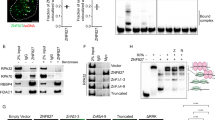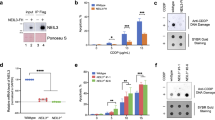Abstract
Zinc-finger protein 143 (ZNF143) is a human homolog of Xenopus transcriptional activator staf that is involved in selenocystyl tRNA transcription. We previously showed that ZNF143 expression is induced by treatment with DNA-damaging agents and that it preferentially binds to cisplatin-modified DNA. In this study, the potential function of ZNF143 was investigated. ZNF143 was overexpressed in cisplatin-resistant cells. ZNF143 knockdown in prostate cancer caused increased sensitivity for cisplatin, but not for oxaliplatin, etoposide and vincristine. We also showed that ZNF143 is associated with tumor suppressor gene product p73 but not with p53. p73 could stimulate the binding of ZNF143 to both ZNF143 binding site and cisplatin-modified DNA, and modulate the function of ZNF143. We provide a direct evidence that both Rad51 and flap endonuclease-1 are target genes of ZNF143 and overexpressed in cisplatin-resistant cells. Taken together, these experiments demonstrate that an interplay of ZNF143, p73 and ZNF143 target genes is involved in DNA repair gene expression and cisplatin resistance.
This is a preview of subscription content, access via your institution
Access options
Subscribe to this journal
Receive 50 print issues and online access
$259.00 per year
only $5.18 per issue
Buy this article
- Purchase on Springer Link
- Instant access to full article PDF
Prices may be subject to local taxes which are calculated during checkout







Similar content being viewed by others
References
Altaha R, Liang X, Yu JJ, Reed E . (2004). Excision repair cross complementing-group 1: gene expression and platinum resistance. Int J Mol Med 14: 959–970.
Bhattacharyya A, Ear US, Koller BH, Weichselbaum RR, Bishop DK . (2000). The breast cancer susceptibility gene BRCA1 is required for subnuclear assembly of Rad51 and survival following treatment with the DNA cross-linking agent cisplatin. J Biol Chem 275: 23899–23903.
Chaney SG, Sancar A . (1996). DNA repair: enzymatic mechanisms and relevance to drug response. J Natl Cancer Inst 88: 1346–1360.
Cohen SM, Lippard SJ . (2001). Cisplatin: from DNA damage to cancer chemotherapy. Prog Nucleic Acid Res Mol Biol 67: 93–130.
De Laurenzi V, Costanzo A, Barcaroli D, Terrinoni A, Falco M, Annicchiarico-Petruzzelli M et al. (1998). Two new p73 splice variants, γ and δ, with different transcriptional activity. J Exp Med 188: 1763–1768.
Fujii R, Mutoh M, Niwa K, Yamada K, Aikou T, Nakagawa M et al. (1994). Active efflux system for cisplatin in cisplatin-resistant human KB cells. Jpn J Cancer Res 85: 426–433.
Imamura T, Izumi H, Nagatani G, Ise T, Minoru N, Iwamoto Y et al. (2001). Interaction with p53 enhances binding of cisplatin-modified DNA by high mobility group 1 protein. J Biol Chem 276: 7534–7540.
Ise T, Nagatani G, Imamura T, Kato K, Takano H, Nomoto M et al. (1999). Transcription factor Y-Box binding protein 1 binds preferentially to cisplatin-modified DNA and interacts with proliferating cell nuclear antigen. Cancer Res 59: 342–346.
Ishiguchi H, Izumi H, Torigoe T, Yoshida Y, Kubota H, Tsuji S et al. (2004). ZNF143 activates gene expression in response to DNA damage and binds to cisplatin-modified DNA. Int J Cancer 111: 900–909.
Izumi H, Ohta R, Nagatani G, Ise T, Nakayama Y, Nomoto M et al. (2003). p300/CBP-associated factor (P/CAF) interacts with nuclear respiratory factor-1 to regulate the UDP-N-acetyl-alpha-D-galactosamine: polypeptide N-acetylgalactosaminyltransferase-3 gene. Biochem J 373: 713–722.
Keshelava N, Zuo JJ, Chen P, Waidyaratne SN, Luna MC, Gomer CJ et al. (2001). Loss of p53 function confers high-level multidrug resistance in neuroblastoma cell lines. Cancer Res 61: 6185–6193.
Kohno K, Izumi H, Uchiumi T, Ashizuka T, Kuwano M . (2003). The pleiotropic functions of the Y-box-binding protein, YB-1. Bioessays 25: 691–698.
Kohno K, Uchiumi T, Niina I, Wakasugi T, Igarashi T, Momii Y et al. (2005). Transcription factors and drug resistance. Eur J Cancer 41: 2577–2586.
Kuwano M, Oda Y, Izumi H, Yang SJ, Uchiumi T, Iwamoto Y et al. (2004). The role of nuclear Y-box binding protein 1 as a global marker in drug resistance. Mol Cancer Ther 3: 1485–1492.
Lieber MR . (1997). The FEN-1 family of structure-specific nucleases in eukaryotic DNA replication, recombination and repair. Bioessays 19: 233–240.
Murakami T, Shibuya I, Ise T, Chen AS, Akiyama S, Nakagawa M et al. (2001). Elevated expression of vacuolar proton pump genes and cellular pH in cisplatin resistance. Int J Cancer 93: 869–874.
Myslinski E, Krol A, Carbon P . (1998). ZNF76 and ZNF143 are two human homologs of the transcriptional activator staf. J Biol Chem 34: 21998–22006.
Ohga T, Koike K, Ono M, Makino Y, Itagaki Y, Tanimoto M et al. (1996). Role of the human Y box-binding protein YB-1 in cellular sensitivity to the DNA-damaging agents cisplatin, mitomycin C, and ultraviolet light. Cancer Res 56: 4224–4228.
Raymond E, Faivre S, Chaney S, Woynarowski J, Cvitkovic E . (2002). Cellular and molecular pharmacology of oxaliplatin. Mol Cancer Ther 1: 227–235.
Rincon JC, Engler SK, Hargrove BW, Kunkel GR . (1998). Molecular cloning of a cDNA encoding human SPH-binding factor, a conserved protein that binds to the enhancer-like region of the U6 small nuclear RNA gene promoter. Nucleic Acids Res 26: 4846–4852.
Schaub M, Myslinski E, Schuster C, Krol A, Carbon P . (1997). Staf, a promiscuous activator for enhanced transcription by RNA polymerase II and III. EMBO J 16: 173–181.
Spiro C, McMurray CT . (2003). Nuclease-deficient FEN-1 blocks Rad51/BRCA1-mediated repair and causes trinucleotide repeat instability. Mol Cell Biol 23: 6063–6074.
Sugaya M, Takenoyama M, Osaki T, Yasuda M, Nagashima A, Sugio K et al. (2002). Establishment of 15 cancer cell lines from patients with lung cancer and the potential tools for immunotherapy. Chest 122: 282–288.
Tanabe M, Izumi H, Ise T, Higuchi S, Yamori T, Yasumoto K et al. (2003). Activating transcription factor 4 increases the cisplatin resistance of human cancer cell lines. Cancer Res 63: 8592–8595.
Tew KD . (1994). Glutathione-associated enzymes in anticancer drug resistance. Cancer Res 54: 4313–4320.
Torigoe T, Izumi H, Ishiguchi H, Yoichiro Y, Mizuho T, Takeshi Y et al. (2005). Cisplatin resistance and transcription factors. Curr Med Chem Anticancer Agents 5: 15–27.
Uramoto H, Izumi H, Ise T, Tada M, Uchiumi T, Kuwano M et al. (2002). p73 interacts with c-Myc to regulate Y-box-binding protein-1 expression. J Biol Chem 277: 31694–31702.
Uramoto H, Izumi H, Nagatani G, Ohmori H, Nahasue N, Ise T et al. (2003). Physical interaction of tumour suppressor p53/p73 with CCAAT-binding transcription factor 2 (CTF2) and differential regulation of human high-mobility group 1 (HMG1) gene expression. Biochem J 371: 301–310.
Vikhanskaya F, Marchini S, Marabese M, Galliera E, Broggini M . (2001). p73α overexpression is associated with resistance to treatment with DNA-damaging agents in a human ovarian cancer cell line. Cancer Res 61: 935–938.
Wood RD, Mitchell M, Lindahl T . (2005). Human DNA repair genes, 2005. Mut Res 577: 275–283.
Zamble DB, Lippard SJ . (1995). Cisplatin and DNA repair in cancer chemotherapy. Trends Biochem Sci 20: 435–439.
Acknowledgements
This work was supported in part by the Ministry of Education, Culture, Sports, Science, and Technology of Japan (Mext), Kakenhi (13218132 and 18590307) and a Grant-in-Aid for Cancer Research from the Fukuoka Cancer Society, Japan.
Author information
Authors and Affiliations
Corresponding author
Additional information
Supplementary Information accompanies the paper on the Oncogene website (http://www.nature.com/onc).
Supplementary information
Rights and permissions
About this article
Cite this article
Wakasugi, T., Izumi, H., Uchiumi, T. et al. ZNF143 interacts with p73 and is involved in cisplatin resistance through the transcriptional regulation of DNA repair genes. Oncogene 26, 5194–5203 (2007). https://doi.org/10.1038/sj.onc.1210326
Received:
Revised:
Accepted:
Published:
Issue Date:
DOI: https://doi.org/10.1038/sj.onc.1210326



